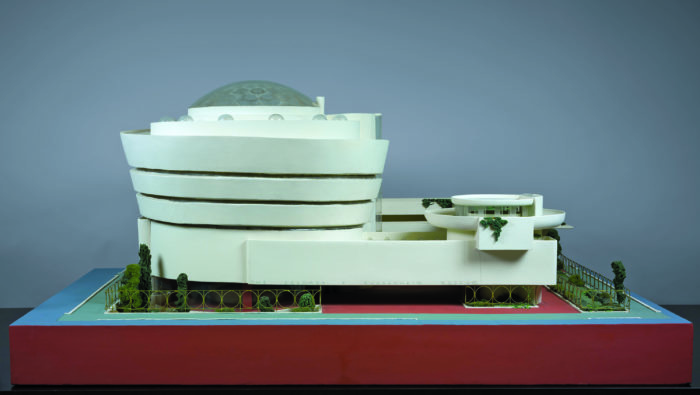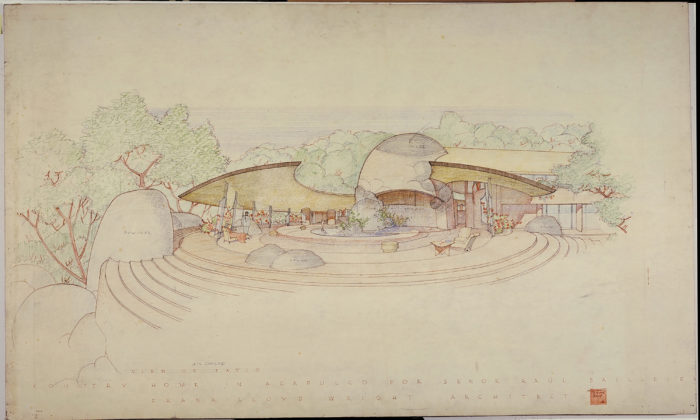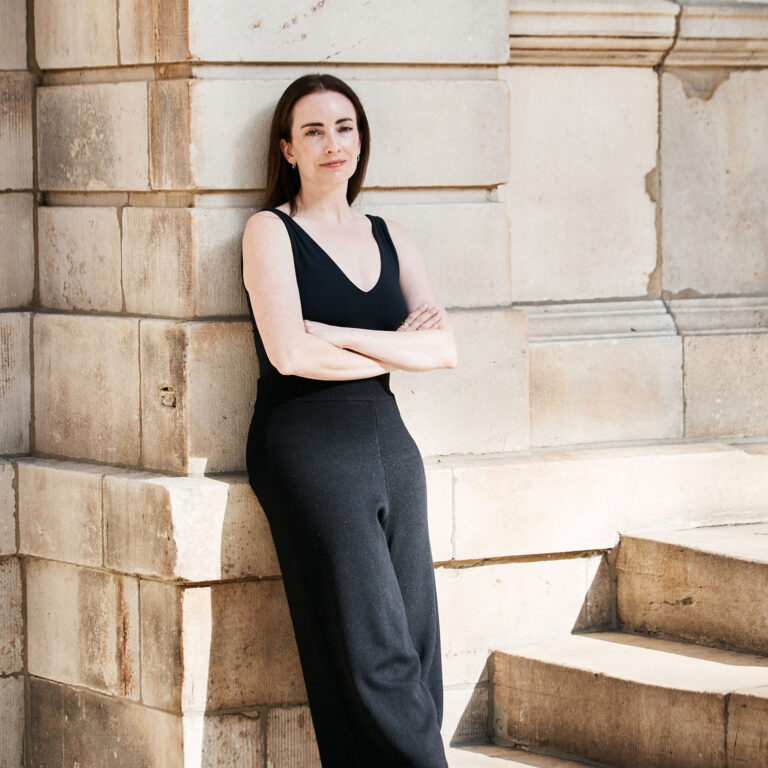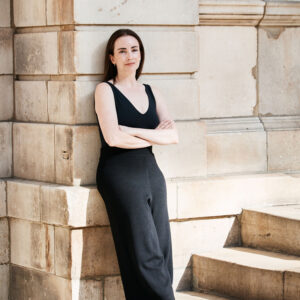
Curator and historian Barry Bergdoll was instrumental in securing the Frank Lloyd Wright archives for MoMA. Now, five years after their arrival, he’s organized one of this year’s most anticipated shows, “Frank Lloyd Wright at 150: Unpacking the Archive.” Contributing Editor and architect Andrew Heid visits the archives at MoMA with Bergdoll to get a preview of this expansive show.
Andrew Heid: I wanted to begin with your first show at MoMA. Was that “Mies in Berlin?”
Barry Bergdoll: Yes, but I did “Mies in Berlin” with Terry Riley. That was during Terry’s time, in 2001, and I was the outside guest curator. How did he approach you? I had written on Karl Friedrich Schinkel and I had taught 19th century things and about 19th century Germany. So he phoned and told me about the project and said he would love to do it with me. And I said well that doesn’t make any sense because I am not a Mies specialist, nor am I a 20th century specialist, so maybe you should find a Mies person. And he said I don’t want a Mies person. I don’t want a show that tell us what we already know about Mies. I want a show that has a chance to see Mies differently. And I want to look at his Berlin career. And this I thought that was a terrific hypothesis.
The archive is all right here?
Well, most of it; all of the drawings are here. And half of the correspondence because Mies divided those very mysteriously, between office correspondence and private correspondence. The office correspondence are here and the private correspondence is in the Library of Congress—but nobody understands that because his office and his house were the same place. This whole office is built around a vault and in the center is the Mies archive—and holding pens for things that are coming and going from the museum warehouse in Queens. But since so many scholars come to use the Mies things we keep it right here, like a library.

And moving forward to the upcoming show, I wanted to bring up a book that I think has some relevance to it, “Three Master Builders,” by Peter Blake. That book has always been an influence in my thinking of Mies, Corbusier and of course Frank Lloyd Wright. Looking at the three master builders as the master of space, the master of form and the master of structure, how would you situate Wright within those categories?
That would have driven Frank Lloyd Wright absolutely crazy. He would say how could you separate those things? Architecture is always a unity. His whole concept of organic design would go out the window if he had to decide there was some possibility of separation between space and structure. It’s like doing the tango by yourself.
You had done a small show on Wright in 2014, the first to show him in relation to the city and the skyscraper. Was that a preview of coming attractions?
Kind of. Well it was the first welcoming of the archive to New York. Somebody wrote something along the lines of ‘Bergdoll is really perverse, last year he tried to convince us that Le Corbusier was all about nature and this year he is trying to convince us that Frank Lloyd Wright is all about the city.’ I thought, I love that! Because I think it is very useful to almost to take the category that people think something is absolutely not about and look at it.
So what is the dialectic for Wright this time around?
This is a very different exercise. I don’t have the same kind of need and affinity for Wright that I had for the other figures that I have worked with. So for better or worse, I’m not a kind of Wright hugger. And so when the proposal for bringing Wright’s archive to New York came up it’s not that I devoted my life to Wright and had to have his archive, I just thought he is so absolutely fundamental that we had to get the archive. There is a responsibility with the archive, and I think it could be drawn on over and over again. It is filled with a reach of possibilities, but we had agreed that we would do a show within a year to welcome the archive to New York. I picked the city theme because it seemed an appropriate way to welcome Wright to New York, it was to take on his ambivalent and very complicated relationship to the urban and to New York. And we also agreed that we would do another show within five years, and it is now the fifth anniversary.
It is the fifth year since that show?
It has been five years since the archive arrived. Since the agreement was signed in 2012 that the stewardship of the Wright archive’s two million pieces of paper would move from the Frank Lloyd Wright Foundation to Columbia University and MoMA. So 2017 is the fifth anniversary of the transfer of the archive to New York, and it just so happens that it is the 150th birthday of Frank Lloyd Wright.

Oh wow, how convenient.
So then, contrary to Mies (who I worked on with Terry) and Le Corbusier (who I worked on with Jean-Louis Cohen) for Wright I didn’t have an immediate new idea. With Mies it was very clear; we were going to establish a dialectic between the debate on nature, the landscape and the garden, and the urban. With Le Corbusier, it was very clear we were going to extend this ongoing project of thinking of the modern movement not in opposition to nature but something that has interesting ideas about nature and that this old rejection of Modernism is somehow anti-nature and anti-place. If I have one big gig going on the 20th century, it is to dispute this notion that Modernism is universal for all places at all times. And it is not critical regionalism, but I would say there is a sensitivity to site, place and landscape.
It is really industrialization. Would you argue that is the universalizing force of the 20th century?
Yes, perhaps and other forces of modernization. In any case, when it came to Wright there must be at least 50 people in this country who preoccupy themselves on a daily basis with Wright, I wasn’t going to join that club. What do I have to say that would take on all seven decades of his career, over a thousand projects, over 400 buildings completed? And I don’t know whether it was on the subway or in the middle of the night that it suddenly occurred to me that this exhibition, unlike the others is not a new vision of Wright brought together by a duo. It is a celebration of the archive being in New York and opening the archive to new perspectives. So, instead of taking it on myself, I am taking a completely different approach and invited more than a dozen other guest curators so that there are 14 of us taking an object and contextualizing it. The show is called “Unpacking the Archive” and it does not add up to a comprehensive view of Wright at all; it is a real kaleidoscope of facets of which some are quite well known and others are very little known.
How democratic.
And the show is as much about Wright as it is about the guest curators, the unpackers. So this is a show that is very overtly how you develop a historical argument from an archive. It is not just about Wright; it is about the Wright archive.
How did you “unpack” all of this besides the archival documents and text?
As you enter in each section of the show there are three pieces—there is what you call the key object, the drawing, model, or in my case a television show—a text and then a large-screen television in which you will see a film of about four minutes that comes out of filming people at the archive. In this way, visitors will understand what it means to work in an archive, and understand that everything that is seen on the wall was found in the archive. So unlike most shows where the things are on the wall, and most people don’t think about why they picked this, the actual act of choosing is going to be in the show.

Why do you think Wright is not respected in schools of architecture, to the extent that Mies and Le Corbusier are?
Well, it depends in which schools of architecture of course. But not in the East Coast schools.
The easy response, which is what Philip Johnson said, “Wright is the greatest architect of the 19th century,” so he was just a generation too early.
But on the other hand, I think that what people do admire are the floor plans of the prairie houses. So in fact it’s precisely the earliest period that is most frequently studied, even if it is studied with some sense of duty. And then there are a handful of buildings that I think everybody admires, architects and non-architects alike, like Falling Water and the Guggenheim even if they’re idiosyncratic.
And it is a similar phenomenon I would say for Frank Gehry; he has an incredible public persona, yet in most schools, he is not exactly revered.
We did a children’s book here two years ago, called “Young Frank” that is about a little boy name Frank who comes to the design galleries at MoMA and he sees a chair that he thinks is really cool and it turns out it is by Frank Lloyd Wright and then he sees another chair made out of cardboard that turns out to be by Frank Gehry and then he realizes that all of these people that have designed these amazing objects are all called Frank—and he is called Frank—and that maybe he could be an architect himself. It’s a little children’s book about discovering the desire to be a designer.
But I guess that is another reason that there is this cultural cliche that their work appeals to. That it could be understood at this kind of simplistic level—at an appealing level that people understand. It is not removed like Rem Koolhaas from everyday discourse, it is difficult to understand his buildings. Like people go to Seattle Central Library and they don’t understand it.
Also, I think the popularity of Wright is that he did mostly houses. And even though they were thought to be quite radical and shocking—particularly the prairie houses—to people circa 1900, today I think they are thought of as cozy and welcoming. Therefore, people respond to the tactile, cozy aspect of early Wright.

And also it was the template for the kind of contemporary mid-century ranch. This kind of room, the great room, that everything led into—the living space, the dining space, the family space. And, as you’ve said before, that the most popular architectural format is houses because people are infinitely interested in how other people live.
And they can associate with that because they live in one. Which is why when I did “Home Delivery,” which for me was about prefabrication and mass customization and the digital revolution, but to many people it was a show about houses. But I did that on purpose because I knew if I made the house the vehicle, it’s a bit like putting the pill in the ice cream when you are sick. The house type was the vehicle for the draw.
So what’s next? Are you just focused on this? Did you start a plan for something after? Are you retiring back to Columbia University?
I don’t know. We’ll see what comes next… this show is so consuming, we’ll see. I have a million ideas of things that I think ought to be done, which I think is also interesting about exhibitions because you don’t just do an exhibition because you can do it. I think in a place that is as public as MoMA that draws so many people, there is an ability to bring together the general audience, and also talk to architects, and to try to do the two at the same time. I think that is why it is so heavily criticized. You know you could do the perfect show that architects would like in an architectural center—the general public wouldn’t come—you could do it exactly how the architects want; you wouldn’t be subject to certain criticism. You have to find the meeting point of your own passions and that of what you believe is important. I wanted to touch on what I think of as blockbuster, politically engaged shows, “Rising Currents” and “Foreclosed” Which were about engaging the public about how architects think. Maybe you don’t see the Wright show in the same trajectory as those shows, but do you see a return of this kind of emphasis—perhaps in your future interests?
Yes. And I hope very much as the department develops with Martino’s leadership that the model does not get lost. I don’t think that there is one type of exhibition—and in particular when it comes to architecture, with all of the difficulties of showing it. So the one that I call the activist exhibition is most clearly and emphatically demonstrated by “Rising Currents” and “Foreclosed.”

I ask that question because it seems that with the new President, those kinds of shows have a kind of urgency in an institution like this.
Yes, they are more of a form of resistance. They are very different in their nature and have a different set of objectives but I do think they share this notion of interpreting the platform, the task, the built-in audience of this place to do things that are enormously important.
So those activist exhibitions are twofold: One, they take on absolutely urgent issues that are not supplied by the marketplace. That is, to do what we need to do which is show that architecture can be in a leadership position and that on issues of absolutely urgent national and international importance (this is a mantra as you know) that design has a place at the table—rather than calling in design to decorate what is decided in another vain. Design thinking is part of the conversation absolutely organically and inherently. And two, is that we did those exhibitions in order also to gain the ear of people in political positions. We had people from city and regional government coming to visit the shows and workshops. These were little workshops, but the range of people that we engaged were from the general public, to architecture students, to architects, to public officials. To get that cross section of interested parties was quite the gamble.
And so relevant today.
We are in a cultural moment with tourism and museums. Architecture impacts everyone’s life in a way that contemporary art doesn’t. But it doesn’t make headlines in the same way. So we are in this incredible moment that some museums are filled to the gill, but if you go down the list of the most visited museums in the world, it’s a challenge to think of one that actually takes on the hard task of showing architecture that has the visiting statistics of MoMA. Our profession, our discipline, our concern has not managed to get a beach head in any of those other places, so this is an incredibly important platform and while not unique, it can’t be squandered.
So the big question is just how long can this bizarre phenomenon continue? That people flock to art museums when you can only look at the paintings here—yet you can at a much higher resolution on Google art—and you don’t have 16 people trying to take a selfie between you and the painting.










 in your life?
in your life?

